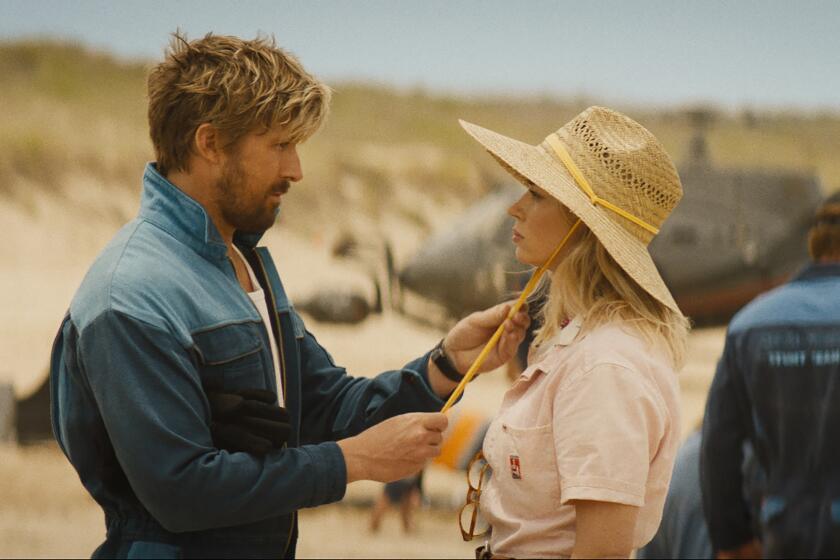New rules for ‘based on a true story’
The five scariest words in cinema: “Based on a true story.”
That familiar disclaimer is so ubiquitous as to be virtually invisible. But consider those five words more closely: At once grandiose and weaselly, full of both historical gravitas and mushy ambiguity, proclaiming both fact (it’s a true story) and fiction (not so fast, we said “based on”), they elegantly, if inadvertently, distill the ethos of a movie industry that has always strived to have it both ways.
Whether it precedes a biographical film or a historical drama, “based on a true story” has come to convey several, often contradictory, ideas simultaneously to wary filmgoers: The events about to transpire on screen really happened, to the very people you’re about to see, at the same time, and to the same end.
Except, of course, when they didn’t happen and the people didn’t exist and we scrambled the time frame and changed the ending. (Hey, we said “based on.”) This is our story, we’re sticking to it, and we’ve left the fact-checking to picky historians, outraged family members, alert critics and Wikipedia.
The stakes wouldn’t be so high if movies weren’t so effective. Because the cinema -- with its outsize scale, sensory immersion and heightened realism -- tends to colonize our imaginations so completely, biographical and historical dramas are graded on a higher curve than any other genres.
Consider “American Gangster.” A hit at the box office and with critics, it’s been hailed as an epic crime drama that tells the story of real-life Harlem drug dealer Frank Lucas (Denzel Washington) and his Javert, N.J., prosecutor Richie Roberts (Russell Crowe) with equal parts style and soaring ambition. But nothing gold can stay: Roberts, who with Lucas served as a consultant on Ridley Scott’s film, has complained that Scott punched up his personal story to make him less sympathetic (abandoning children he never had, for example). And several critics have excoriated the film for burnishing Lucas’ image, making him out to be an upright, churchgoing family man with a romantic, outlaw shadow life.
Then there’s “I’m Not There,” Todd Haynes’ biopic about Bob Dylan that stars Cate Blanchett -- along with five other actors -- as one of several Dylan personas. Less a biopic than a fever dream of impressions, digressions and speculations, “I’m Not There” is preceded by the disclaimer, “Inspired by the music and many lives of Bob Dylan.”
And so it goes. We love our biopics, sometimes we hate our biopics, but one thing’s for certain: We desperately need our biopics. Since Thomas Edison’s 1895 “The Execution of Mary, Queen of Scots,” film has been the favored vector for creating a usable past, from “Young Mr. Lincoln” to “Walk the Line.” Biopics have told a nation who our heroes are, what deserves to be remembered, what counts as history. They tell us who we are. And precisely because movies are such a potent form of forging historical consensus, not only are they expected to hew to particular aesthetic standards but factual standards as well.
The poster boy for operating a camera with too much artistic license, of course, is Oliver Stone, whose 1991 film “JFK” still stands as its era’s master narrative of postmodern historical revisionism, breathing life into a grand unified conspiracy theory and sending viewers down a hallucinatory double helix of baby boomer paranoia and nostalgia. (The outrage of “JFK’s” detractors was mirrored three years earlier by critics of “Mississippi Burning,” which sinned in both erasing African Americans and elevating white FBI agents in the civil rights story.)
“JFK” is still driving fact checkers crazy, but no fact-based movie can be released now without the requisite push back from a truth squad, usually composed of academic historians, geeked-out buffs or, most commonly, outraged friends and family members.
Just this summer, the family of Ralph “Petey” Greene announced their displeasure with “Talk to Me,” in which Don Cheadle portrayed the late Washington disc jockey. The movie, they said, misrepresented Greene as an alcoholic womanizer, and it mischaracterized his relationship with radio executive Dewey Hughes.
For her part, “Talk to Me’s” director, Kasi Lemmons, said she intentionally stayed away from reading Greene’s biography, for both legal and artistic reasons. “I thought I might get distracted with too much reality,” she said when the movie came out. “And I wanted a movie, not a biopic.”
In defending her decision to stray from the literal facts, Lemmons reveals myriad truths about the perils of making -- and watching -- a fact-based drama, perils that are both philosophical and aesthetic. What are the ethics of portraying actual lives and historical events on screen? (And do movies, with their uniquely potent ability to burrow into the collective consciousness, have an added obligation to the factual record?)
The controversy, like all others before and after it, shines a light on what is essentially a tacit contract between filmmakers and their audience, one that allows writers and directors unfettered poetic license with the understanding that, to quote documentary maker Ken Burns, they won’t slip on the “razor’s edge between fraud and art.”
Of course, one viewer’s fraud is another’s art. With biopics as popular as ever, surely it’s time to agree to a few shared principles of how to make them. A set of best practices for filmmakers that, while not guaranteeing art, might at least prevent fraud:
* Tell the truth when you can. Lie if you have to. One of the best scenes in “The Queen,” for which Helen Mirren won last year’s actress Oscar for her portrayal of Queen Elizabeth, is one in which newly elected Tony Blair (Michael Sheen) meets the title character for the first time, a chamber masterpiece of psychological maneuverings and whisper-subtle politics. The fact that it never happened doesn’t insult British parliamentary protocol as much as it brilliantly and economically conveys the far larger, more nuanced truth of the fascinating relationship between Blair and his queen.
Accuracy is the great bugaboo of biopics and historical dramas, whose standards of success lie in how well they tell a story, not how closely they adhere to the facts. Filmmakers should excise, compress and invent -- in other words, lie -- only when they have to, and only to support, rather than weaken, the story’s factual, historical framework. (See also: “Coal Miner’s Daughter.”)
* Indulge in the creative anachronism. The power of film lies in its realism, its unique ability to re-create people and events with convincing verisimilitude.
The realist trap has led too many filmmakers to create cinematic waxworks, on-the-nose reenactments that are as aesthetically dead as their subjects. Far more vibrant are the films that present history as a dialogue between past and present.
Thus, Sofia Coppola’s pink Chuck Taylors peeking out of a closet in “Marie Antoinette” remind viewers that they’re watching an interpretation of a life, not the life itself. It also encourages them to consider how the isolation and corruption depicted on screen may be playing out in present-day imperial politics, and adds a welcome note of playfulness to the proceedings. Similarly, Emanuele Crialese, in his visionary historical drama “Golden Door” earlier this year, infused an otherwise cliched immigrant narrative with brief, abstract scenes -- of Italian immigrants floating down a river of milk, for example -- that simultaneously enlivened the film visually and poetically communicated its themes of hope and self-deception. (See also: “Walker,” “The Moderns.”)
* Embrace ambiguity. Of the myriad perils in depicting a life on screen, one of the most insidious is that one person’s version gets to be the official story; once a filmmaker has bought into a subject’s story -- often literally, by purchasing his or her biography, memoir or “life rights” -- they proceed to ignore any dissenting voices that might detract from or contradict the (usually heroic) tale they’re telling. Video store remainder bins are full of filmic hagiographies, from “The Spirit of St. Louis” to “Get Rich or Die Tryin’.”
But a recent example of raising the artistic and ethical bar was Sean Penn’s “Into the Wild,” an adaptation of Jon Krakauer’s book about Chris McCandless. Penn used a full palette of cinematic tools to introduce several voices to the story, including on-screen text of McCandless’ own writings, a voice-over narration by his sister, and finally Penn and actor Emile Hirsch’s interpretation of McCandless’ final two years. The result is an unusually sophisticated portrait of an often contradictory protagonist who resists facile pigeon-holing. (See also: “Reds.”)
* You can add footnotes and appendixes; it’s called technology. One of the most common cop-outs for filmmakers accused of playing fast and loose with history is that they have only two hours to tell a life story, while writers have unlimited pages to clarify, substantiate and defend their claims. Well, now filmmakers have unlimited pages too, in the form of DVD extras and websites, where they can present interviews with original sources, include parts of the historical record that were left out in the movie and even present opposing points of view.
* Stop with the same old story. Is there better Oscar bait than a juicy role playing a tormented artist visiting the stations of the creative cross?
Think Jamie Foxx (“Ray”) and Reese Witherspoon (as June Carter Cash in “Walk the Line). Or Marion Cotillard, who is an odds-on favorite to be nominated for an Academy Award for her uncanny portrayal of French chanteuse Edith Piaf in “La Vie en Rose.”
Am I the only one who’s had enough of the discovery-destruction-redemption arc?
Hollywood seems to be in a tortured artist cycle, with films being extruded to assembly-line specifications showing the humble beginnings, flashes of genius and self-indulgent excesses of prodigies (which gets a welcome parody in “Walk Hard”).
The messy, contradictory, adamantly nonlinear truth of a life is much better served by a film that doesn’t shoehorn its subject into a neat, three-act structure. One of the best biopics of all time is “Thirty Two Short Films About Glenn Gould,” Francois Girard’s 1993 portrait of the Canadian pianist that took its structure from Gould’s most famous performance, Bach’s “Goldberg” Variations. The vignettes, some verbatim reenactments, some whole cloth, added up to a rich, vivid film portrait that did justice to its subject by leaving his mysteries intact. (See also: “Fur: An Imaginary Portrait of Diane Arbus,” “American Splendor” and, if you can, a bootleg of Todd Haynes’ 1987 “Superstar: The Karen Carpenter Story,” a biopic enacted entirely by Barbie dolls.)
More to Read
Only good movies
Get the Indie Focus newsletter, Mark Olsen's weekly guide to the world of cinema.
You may occasionally receive promotional content from the Los Angeles Times.






